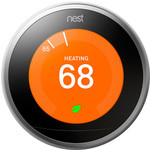Google Nest T3007ES
Highlights
Control Temperature from Smart Devices
2.1" (480 x 480) LCD Display
Built-In 802.11b/g/n Wi-Fi Connectivity
Compatible with Most HVAC Systems
Auto-Schedule Self-Programming
Automatically Adapts to Season Change
Smart Energy Monitoring
Built-In Rechargeable Battery
Wall-Mountable Design
Works with Alexa and Google Assistant
Features
The 3rd generation Google Nest Learning Thermostat in stainless steel adapts to your heating and cooling preferences within a week of installation and can automatically create schedules. This thermostat features built-in Wi-Fi connectivity and can be conveniently controlled via the Nest app for Android and iOS smart devices.
NOTE: These mainly work best with "dumb" HVAC. Check compatibility at https://nest.com/works/


Thanks for sharing. What do I do with this in Australia with two split systems?